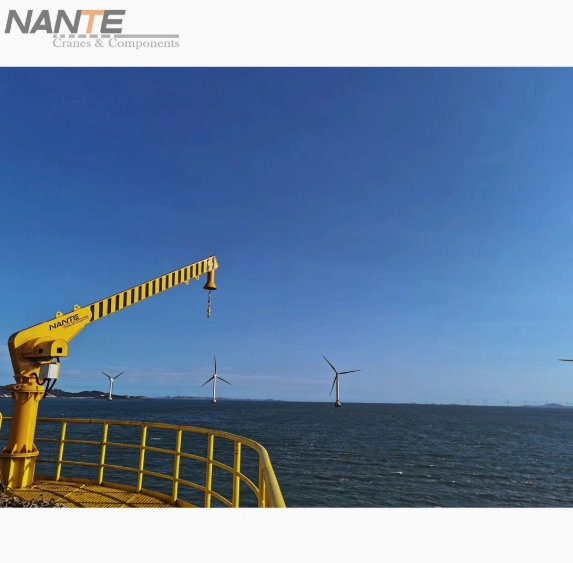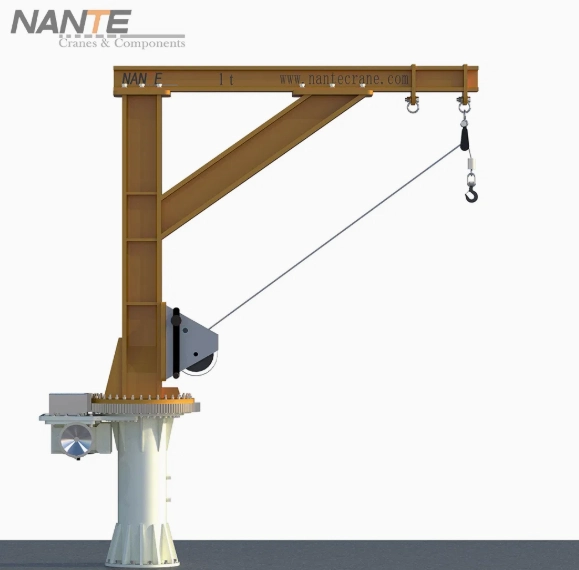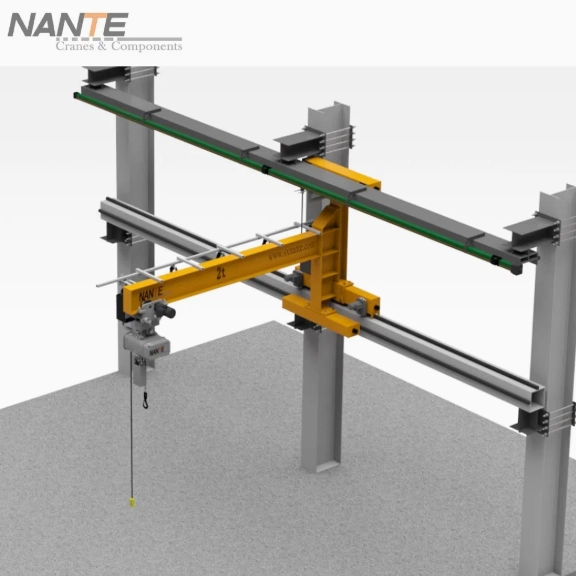Jib Crane for Hazardous Outdoor Corrosive Marine Environment
Jib Crane for Hazardous Outdoor Corrosive Marine Environment
Date: 2025-09-18 Share:
Introduction
The marine world is tough. Saltwater chews up steel. Strong winds push gear around. Explosive risks lurk in places like offshore platforms. In these hard conditions, special jib cranes are super important for safe, quick lifting. Jib cranes, with arms that swing and lift from 150kg to 5000kg, are great for small tasks in risky outdoor spots. Built to fight marine rust, these cranes keep working in shipyards, oil rigs, and ports by the sea.
This blog looks at how anti-rust and explosion-safe jib cranes, made to meet rules like FEM, CMAA, ISO EN, BS, GB, IEC, ATEX, and OSHA 1910.179, stay strong and safe. With stuff like galvanized coatings and IP55 covers, marine jib cranes from Nante Crane are made to last in the roughest places.
Understanding Jib Cranes in Harsh Marine Contexts
What is a Jib Crane and Its Core Functionality?
A jib crane has a tall pole with a swinging arm. It moves 180° to 360° to lift stuff exactly where needed. With hoists, it’s perfect for tight marine spots. In sea settings, jib cranes are awesome. They save space, are easy to use, and set up fast on decks or walls. This makes them great for offshore platforms or shipyards where big cranes don’t work.
Key Challenges in Hazardous Outdoor Corrosive Marine Environments
Marine areas are tricky. Saltwater starts rust that eats metal. Wet air grows tiny bugs. Winds and waves shake things hard. Explosive risks in ATEX or NEC zones, like on oil rigs, make things tougher. These issues can weaken gear, raise repair costs, and cause dangers. For example, OSHA 1910.179 warns about rope wear. You need tough, special cranes to handle this.
Why Prioritize Jib Cranes for Marine Duty?
Jib cranes are flexible compared to big cranes. Their modular parts fit easily on crowded decks. They’re cheap for small lifting jobs in marine spots. They give exact, trusty work where space is tight, making them perfect for risky, rusty marine areas.
Essential Design Features for Durability and Safety
Corrosion-Resistant Materials and Advanced Coatings
Marine jib cranes use strong steel pipes, often 316-grade stainless steel or hot-dipped galvanized to stop rust. Special marine paints, like epoxy or polyurethane, sometimes with sprayed aluminum, protect against pitting in salty air. These steps can make cranes last 50% longer. They stay trusty in tough places like offshore platforms or coastal shipyards.
Weatherproofing and Structural Enhancements
To fight bad weather, jib cranes have IP55 powder-coated covers and sealed silicone gaskets. These shield electrical parts. Low-headroom hoists with rain covers and sturdy bases handle winds over 50 mph. Swinging parts, manual or motorized, use thrust bearings and variable frequency drives (VFDs) for steady control, keeping things safe in gusts or rough seas.
Explosion-Proof Compliance for Hazardous Zones
In risky marine spots, explosion-safe features are a must. Flameproof motors, non-sparking gears, and low-voltage DC electrics meet IECEx and Class I Div 1 rules. Grounding straps stop static risks. Socket plug-ins make safe connections in wet or vapor-heavy areas. These follow ATEX and other safety rules.
Types of Jib Cranes Tailored for Marine Applications
Free Standing Jib Cranes
Free-standing jib cranes lift 250kg to 5000kg with 2-7m arms. They swing 360° with motors for open decks. Galvanized poles keep them steady in offshore conditions. They’re great for oil platforms lifting heavy stuff like drill pipes.
Wall Mounted and Travelling Jib Cranes
Wall-mounted jib cranes lift 250-5000kg and turn 180°. They’re good for ship repair bays. Travelling ones move along harbor walls. Pneumatic trolleys cut electrical risks in salty mists, making work safer and faster in coastal shipyards.
Movable and Articulating Jib Cranes
Movable jib cranes, with 150-1000kg capacity and wheels, have double-pivot arms for all-around reach. Stainless steel arms fight bilge rust. They’re perfect for flexible tasks in marinas or chemical plants.
Real-World Applications and Case Insights
Offshore Oil and Gas Platforms
On offshore platforms, jib cranes lift drill bits and pipes in constant saltwater spray. Explosion-safe hoists with limit switches cut rigging time by 30%. They avoid crashes with derricks in storms. A study showed a free-standing jib crane handling 60 mph winds, keeping work going on a North Sea rig.
Coastal Shipyards and Marinas
In shipyards, wall-travelling jib cranes move hulls and engines. They save 40% labor in tidal mists. With winches, they handle subsea transfers. Anti-rust coatings fight hull-cleaning chemicals, staying strong in wet air.
Marine Cargo and Chemical Facilities
At ports, articulating jib cranes lift risky drums. Movable ones move vats in estuaries. They keep working 24/7 in fog or rain. Load sensors ensure safety in vapor-heavy zones, boosting work in rusty marine cargo tasks.
Maintenance and Safety Best Practices
Routine Inspection and Predictive Tools
Check daily for coating cracks. Lube monthly with marine-grade grease. Do yearly non-destructive testing (NDT) per OSHA and FEM rules. IoT sensors watch vibration and wet air, sending alerts to stop salt buildup and keep cranes running in rusty spots.
Operator Training and Hazard Mitigation
Train workers on load charts and wind checks. They need PPE and harnesses. Bumpers and sensors stop crashes in tight marine spaces. This follows safety rules and cuts risks in dangerous outdoor areas.
Adherence to Global Standards
Jib cranes must meet FEM, CMAA, ISO EN 13001, and BS 7121 for design. Lloyd’s Register certification is key for marine use. Following these ensures strong, safe cranes for offshore and shipyard work in rusty conditions.
About Nante Crane: Your Partner in Reliable Marine Lifting Solutions
Nante Crane is a top name in crane solutions. They make strong jib cranes for tough marine spots. With a focus on new ideas and safety, Nante builds cranes to FEM, CMAA, ISO EN, BS, and GB standards. They use seamless columns, box/I-beam arms, and chain or low-headroom hoists. IP55 covers and galvanized coatings keep cranes tough in saltwater and risky areas. Trusted worldwide, Nante makes solutions for offshore platforms and shipyards, giving trusty, fast work where it counts.
Upgrade your marine work with Nante’s anti-rust, explosion-safe jib cranes. Visit https://www.nantecrane.com/ for custom quotes or advice to boost safety and speed in risky, rusty marine spots today!
FAQ
What materials ensure Nante jib cranes resist marine corrosion?
Nante uses galvanized 316-grade stainless steel, marine-grade epoxy coatings, and IP55-sealed parts to fight saltwater and wet air, keeping cranes strong for years.
Are Nante jib cranes compliant for explosive marine zones?
Yes, Nante’s cranes have IECEx-certified flameproof motors and non-sparking gears. They meet ATEX standards for safe use in risky zones.
How to choose capacity for outdoor marine use?
Pick based on load (150-5000kg), reach (2-7m), and wind factors. Use Nante’s design guide for best results in marine spots.
What maintenance is needed in corrosive settings?
Do daily visual checks, monthly marine-grade lubing, and yearly NDT per OSHA. IoT sensors help stop salt buildup for long crane life.
Can Nante customize for offshore installations?
Yes, Nante offers motorized swinging and wind-strong bases. Certified teams install them to fit offshore platform needs






